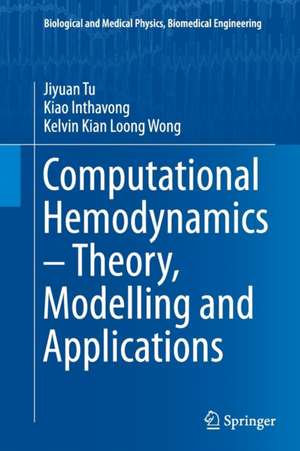Computational Hemodynamics – Theory, Modelling and Applications: Biological and Medical Physics, Biomedical Engineering
Autor Jiyuan Tu, Kiao Inthavong, Kelvin Kian Loong Wongen Limba Engleză Paperback – 13 oct 2016
This unique book is one of the first to bring together knowledge from multiple disciplines, providing a starting point to each of the individual disciplines involved, attempting to ease the steep learning curve. This book presents elementary knowledge on the physiology of the cardiovascular system; basic knowledge and techniques on reconstructing geometric models from medical imaging; mathematics that describe fluid and structural mechanics, and corresponding numerical/computational methods to solve its equations and problems.
Many practical examples and case studies are presented to reinforce best practice guidelines for setting high quality computational models and simulations. These examples contain a large number of images for visualization, to explain cardiovascular physiological functions and disease. The reader is then exposed to some of the latest research activities through a summary of breakthrough research models, findings, and techniques.
The book’s approach is aimed at students and researchers entering this field from engineering, applied mathematics, biotechnology or medicine, wishing to engage in this emerging and exciting field of computational hemodynamics modelling.
| Toate formatele și edițiile | Preț | Express |
|---|---|---|
| Paperback (1) | 1287.38 lei 43-57 zile | |
| SPRINGER NETHERLANDS – 13 oct 2016 | 1287.38 lei 43-57 zile | |
| Hardback (1) | 1294.47 lei 43-57 zile | |
| SPRINGER NETHERLANDS – 23 mar 2015 | 1294.47 lei 43-57 zile |
Din seria Biological and Medical Physics, Biomedical Engineering
- 5%
 Preț: 1110.32 lei
Preț: 1110.32 lei - 18%
 Preț: 1006.55 lei
Preț: 1006.55 lei - 18%
 Preț: 960.78 lei
Preț: 960.78 lei - 18%
 Preț: 704.10 lei
Preț: 704.10 lei - 18%
 Preț: 967.40 lei
Preț: 967.40 lei - 18%
 Preț: 948.92 lei
Preț: 948.92 lei - 15%
 Preț: 641.71 lei
Preț: 641.71 lei - 15%
 Preț: 644.95 lei
Preț: 644.95 lei - 15%
 Preț: 665.08 lei
Preț: 665.08 lei - 18%
 Preț: 1669.16 lei
Preț: 1669.16 lei - 18%
 Preț: 941.05 lei
Preț: 941.05 lei - 18%
 Preț: 956.81 lei
Preț: 956.81 lei - 18%
 Preț: 950.21 lei
Preț: 950.21 lei - 15%
 Preț: 636.80 lei
Preț: 636.80 lei - 18%
 Preț: 947.50 lei
Preț: 947.50 lei - 15%
 Preț: 636.80 lei
Preț: 636.80 lei -
 Preț: 397.01 lei
Preț: 397.01 lei - 18%
 Preț: 1236.99 lei
Preț: 1236.99 lei - 15%
 Preț: 644.49 lei
Preț: 644.49 lei - 18%
 Preț: 946.55 lei
Preț: 946.55 lei - 15%
 Preț: 712.22 lei
Preț: 712.22 lei - 18%
 Preț: 952.89 lei
Preț: 952.89 lei - 18%
 Preț: 944.36 lei
Preț: 944.36 lei - 18%
 Preț: 1228.29 lei
Preț: 1228.29 lei - 5%
 Preț: 1422.67 lei
Preț: 1422.67 lei - 18%
 Preț: 1393.27 lei
Preț: 1393.27 lei - 15%
 Preț: 651.19 lei
Preț: 651.19 lei - 18%
 Preț: 953.65 lei
Preț: 953.65 lei - 18%
 Preț: 955.88 lei
Preț: 955.88 lei - 15%
 Preț: 644.95 lei
Preț: 644.95 lei - 5%
 Preț: 1098.48 lei
Preț: 1098.48 lei - 18%
 Preț: 959.19 lei
Preț: 959.19 lei - 15%
 Preț: 643.65 lei
Preț: 643.65 lei - 5%
 Preț: 1159.16 lei
Preț: 1159.16 lei - 5%
 Preț: 1102.67 lei
Preț: 1102.67 lei - 18%
 Preț: 952.09 lei
Preț: 952.09 lei - 18%
 Preț: 946.55 lei
Preț: 946.55 lei - 18%
 Preț: 952.09 lei
Preț: 952.09 lei - 15%
 Preț: 703.20 lei
Preț: 703.20 lei - 18%
 Preț: 953.65 lei
Preț: 953.65 lei - 5%
 Preț: 1008.41 lei
Preț: 1008.41 lei - 15%
 Preț: 644.82 lei
Preț: 644.82 lei - 18%
 Preț: 956.03 lei
Preț: 956.03 lei - 15%
 Preț: 647.40 lei
Preț: 647.40 lei
Preț: 1287.38 lei
Preț vechi: 1355.14 lei
-5% Nou
Puncte Express: 1931
Preț estimativ în valută:
246.33€ • 257.89$ • 203.83£
246.33€ • 257.89$ • 203.83£
Carte tipărită la comandă
Livrare economică 07-21 aprilie
Preluare comenzi: 021 569.72.76
Specificații
ISBN-13: 9789402407426
ISBN-10: 9402407421
Pagini: 367
Ilustrații: XVI, 351 p. 272 illus., 203 illus. in color.
Dimensiuni: 155 x 235 x 19 mm
Greutate: 0.51 kg
Ediția:Softcover reprint of the original 1st ed. 2015
Editura: SPRINGER NETHERLANDS
Colecția Springer
Seria Biological and Medical Physics, Biomedical Engineering
Locul publicării:Dordrecht, Netherlands
ISBN-10: 9402407421
Pagini: 367
Ilustrații: XVI, 351 p. 272 illus., 203 illus. in color.
Dimensiuni: 155 x 235 x 19 mm
Greutate: 0.51 kg
Ediția:Softcover reprint of the original 1st ed. 2015
Editura: SPRINGER NETHERLANDS
Colecția Springer
Seria Biological and Medical Physics, Biomedical Engineering
Locul publicării:Dordrecht, Netherlands
Cuprins
Computational hemodynamics - an introduction.- The human cardiovascular system.- Geometric model reconstruction.- Fundamentals of hemodynamics.- Computational fluid structure interaction.- Generation of computational mesh for hemodynamics analysis.- Case studies of the human cardiovascular system.- Applications of fsi for cardiovascular hemodynamics.- Advanced topics and future trends.
Recenzii
“The purpose is to describe geometric and mathematical models that can be used to study fluid and structural mechanics in the cardiovascular system. The book is unique in being one of the first to bring together knowledge from multiple disciplines … and present it in a consolidated manner. The audience includes students, health professionals, and researchers entering the emerging and exciting field of computational hemodynamics modeling from engineering, applied mathematics, biotechnology, or medicine.” (Pooja Sethi, Doody's Book Reviews, May, 2015)
Textul de pe ultima copertă
This book discusses geometric and mathematical models that can be used to study fluid and structural mechanics in the cardiovascular system. Where traditional research methodologies in the human cardiovascular system are challenging due to its invasive nature, several recent advances in medical imaging and computational fluid and solid mechanics modelling now provide new and exciting research opportunities. This emerging field of study is multi-disciplinary, involving numerical methods, computational science, fluid and structural mechanics, and biomedical engineering. Certainly any new student or researcher in this field may feel overwhelmed by the wide range of disciplines that need to be understood.
This unique book is one of the first to bring together knowledge from multiple disciplines, providing a starting point to each of the individual disciplines involved, attempting to ease the steep learning curve. This book presents elementary knowledge on the physiology of the cardiovascular system; basic knowledge and techniques on reconstructing geometric models from medical imaging; mathematics that describe fluid and structural mechanics, and corresponding numerical/computational methods to solve its equations and problems.
Many practical examples and case studies are presented to reinforce best practice guidelines for setting high quality computational models and simulations. These examples contain a large number of images for visualization, to explain cardiovascular physiological functions and disease. The reader is then exposed to some of the latest research activities through a summary of breakthrough research models, findings, and techniques.
The book’s approach is aimed at students and researchers entering this field from engineering, applied mathematics, biotechnology or medicine, wishing to engage in this emerging and exciting field of computational hemodynamics modelling.
This unique book is one of the first to bring together knowledge from multiple disciplines, providing a starting point to each of the individual disciplines involved, attempting to ease the steep learning curve. This book presents elementary knowledge on the physiology of the cardiovascular system; basic knowledge and techniques on reconstructing geometric models from medical imaging; mathematics that describe fluid and structural mechanics, and corresponding numerical/computational methods to solve its equations and problems.
Many practical examples and case studies are presented to reinforce best practice guidelines for setting high quality computational models and simulations. These examples contain a large number of images for visualization, to explain cardiovascular physiological functions and disease. The reader is then exposed to some of the latest research activities through a summary of breakthrough research models, findings, and techniques.
The book’s approach is aimed at students and researchers entering this field from engineering, applied mathematics, biotechnology or medicine, wishing to engage in this emerging and exciting field of computational hemodynamics modelling.
Caracteristici
Presents the latest research outcomes through ample and detailed case studies and applications Offers integrated multi-disciplinary knowledge of anatomy, physiology, computer modelling, and fluid-structure interaction dynamics for biomedical research Gives the reader a quick start into the research by best practices guidelines, highlighting common pitfalls researchers encounter, and analysis techniques Includes computational models complete and ready for the reader to use to allow practical hands on learning Includes supplementary material: sn.pub/extras




















